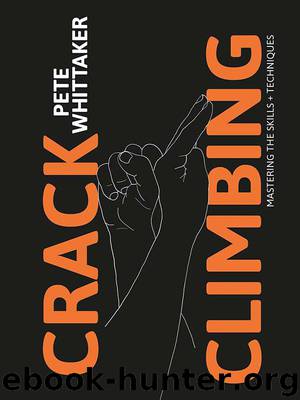Crack Climbing by Pete Whittaker

Author:Pete Whittaker
Language: eng
Format: epub
ISBN: 9781911342779
Publisher: Vertebrate Publishing
Medium width
CHICKENWING
powerful jam, active rotational jam
Imagine the shapes you would make with your arms to imitate a flapping chicken … that gives you a rough idea of the arm position you are looking to achieve in the crack with a chickenwing.
1Orientation: place your hand into the thumb-down position (3.1.1). With your hand in this position, move it so that the back of your hand touches the front of your shoulder and your thumb touches your armpit. This action will fold your arm in half and stick your elbow out to the side (like a flapping chicken). Turn your body – not just your arm – so that you are side on to the crack and the tip of your elbow is pointing into the crack.
2Insertion: insert your arm into the crack elbow first and place the palm of your hand (which should be in a thumb-down position) against the crack wall. So, if you are inserting your right arm, the palm of your right hand will go against the left crack wall. Remember to look for bumps, holds and friction on the rock for your palm to sit against which will help the jam.
3Rotational jam: when your palm is securely in position, rotate your forearm so that the back of your upper arm connects with the opposite wall. The jam will probably feel pretty secure as you are using mechanical advantage rather than pure power. However, remember to push out on the crack wall with the palm of your hand and pull (using your body weight) out of the crack directly from the point where your elbow connects with the crack wall. Doing this creates a rotational jam where the harder you pull on it, the tighter it gets. This is the reason that chickenwings feel so secure.
4Because ‘the harder you pull on it, the tighter it gets,’ it can sometimes be difficult to move on chickenwings. Below are a couple of tips for when it is best to use them:
• Narrow chickenwings: if the jam is very tight, then it is best to use chickenwings for either resting or placing gear. Although they may feel very secure, trying to move on them will feel incredibly awkward. In this situation, it is best to move on arm bars and then rest on chickenwings.
• Wider chickenwings: when the crack gets wider and your chickenwing becomes more ‘tipped out’ – i.e. the distance between your thumb and armpit increases – the chickenwing can be a great technique for movement: it can be easily released and moved upwards, yet when seated properly it will feel secure and less powerful than an arm bar. To release a chickenwing effectively and efficiently, push your elbow into the crack, release the outward pressure you’re exerting with the palm of your hand, and move your thumb back to your armpit. Once released, shuffle it upwards and reposition it. Only very small shuffles can be made when chickenwinging.
The chickenwing can be used at different angles in the crack, depending on the steepness of the rock or whether you are resting or moving.
Download
This site does not store any files on its server. We only index and link to content provided by other sites. Please contact the content providers to delete copyright contents if any and email us, we'll remove relevant links or contents immediately.
| Excursion Guides | Mountain Climbing |
| Rock Climbing |
Annapurna by Maurice Herzog(2834)
Into Thin Air by Jon Krakauer(2695)
SAS Survival Handbook by John 'Lofty' Wiseman(2255)
The Ogre by Doug Scott(2105)
Reservoir 13 by Jon McGregor(1848)
Everest the Cruel Way by Joe Tasker(1823)
The End of Eddy by Édouard Louis(1744)
Touching the Void by Joe Simpson(1703)
The Push by Tommy Caldwell(1682)
Iced In by Chris Turney(1577)
The Call of Everest by Conrad Anker(1547)
The Isle of Mull by Terry Marsh(1516)
Miracle in the Andes by Nando Parrado(1489)
Touching the Void (1987) by Joe Simpson(1411)
Mud, Sweat, and Tears by Bear Grylls(1295)
Himalaya Bound by Michael Benanav(1255)
Higher Calling by Max Leonard(1238)
Death Grip by Matt Samet(1158)
Backcountry Bear Basics by Dave Smith(1128)
